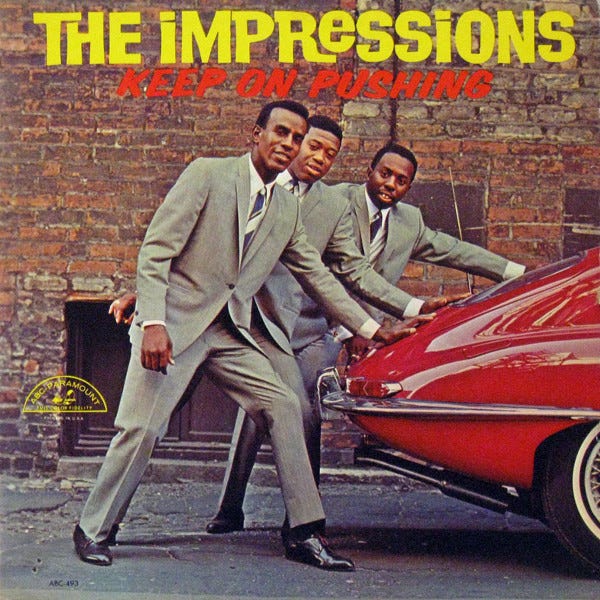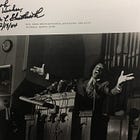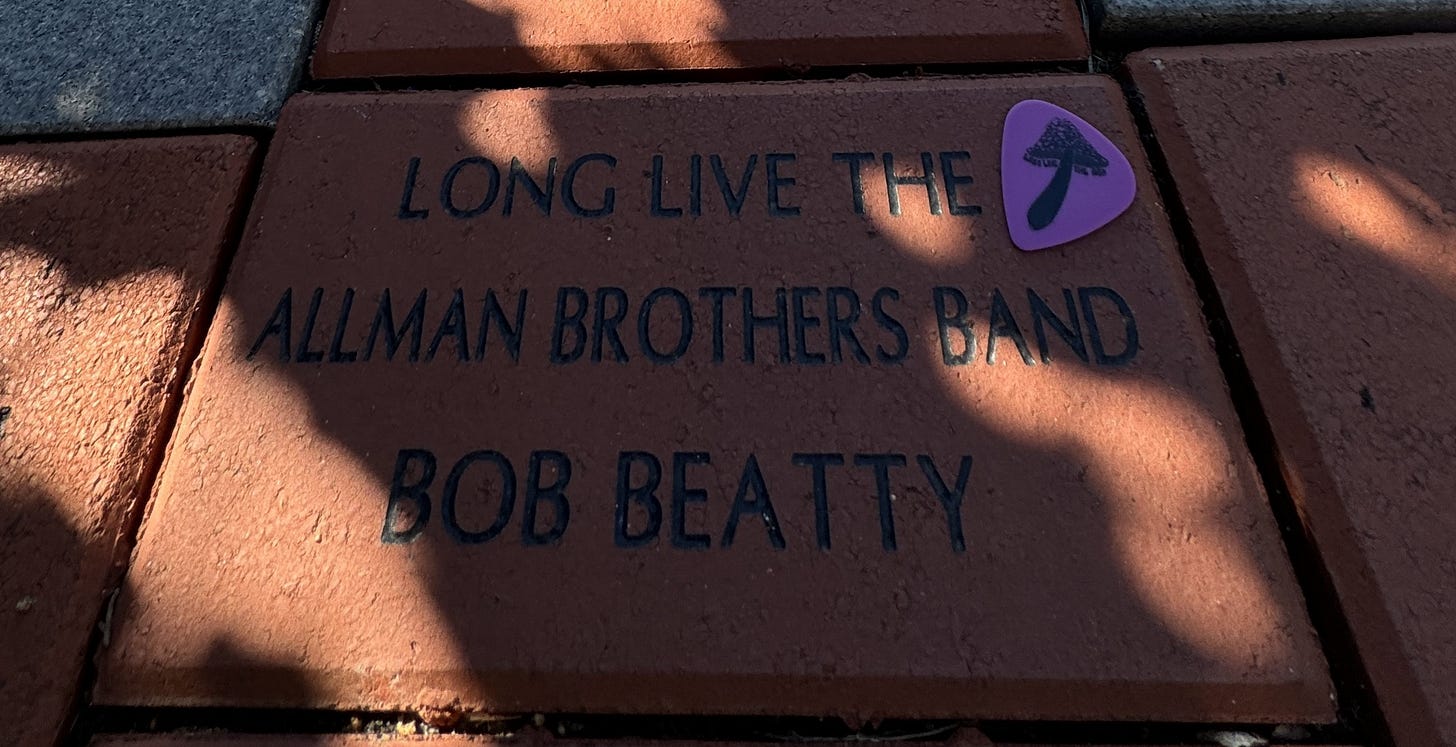In fall 1997, I took my first-ever history graduate class, the History of the New South. The class remains among the most profound experiences of my life, partially because it was my first semester of grade school1 but mostly because of the rigor it required and the way it helped me reframe lingering questions I had about growing up in the South, my South.
A key part of the course, and of the history of the South—old and new2—is the race question. I’ve continued to explore the subject; how Duane and his bandmates navigated the South’s racial mores and boundaries is core to how the ABB story plays out in Play All Night.
Music and the Civil Rights Movement
I’ve always been particularly struck by the courage of those who participated in the modern Civil Rights Movement and music was synonymous with the Movement. Few artists were more important than the Impressions. Curtis Mayfield, their leader, together with Sam Gooden and Fred Cash, sang songs of encouragement to Black America. Their music communicated the messages of the Civil Rights Movement and his embrace of the principles of Black empowerment stands among his most enduring legacies.
More on Mayfield below, I’ll start with the Allman Brothers Band connections.
I had the privilege of curating an exhibition on the Impressions a few years back. It gave me the opportunity to learn more about Curtis Mayfield as an artist, including his influence on Duane Allman. Here are some of the connections I made.
Hour Glass
There are several references to the Impressions being part of Duane & Gregg’s repertoire but the only recording I know of is Hour Glass on “I’ve Been Trying” from their self-titled debut album. It’s a pretty true-to-form cover, nothing remarkable, but a more-than-passable version.
Listen for yourself:
🎶 The Impressions “I’ve Been Trying” (1964)
🎶 Hour Glass “I’ve Been Trying” (1967)
Mayfield’s influence on Duane
Two quotes from Gregg are all I’ve got.
🍄“Duane and Dickey spent a lot of time together, working out all those harmony lines. I’d give them a basic line of what I wanted on some songs, or they would take a basic line out of the melody and try to complement that. My brother was way into that, because he was way into Curtis Mayfield.”3
🍄“He loved players like Curtis Mayfield and wanted the bass, keyboards, and second guitar to form patterns behind the solo.”4
You have to listen pretty closely to hear what Gregg’s talking about.
Mayfield didn’t have his guitar high in the mix and Curtis’s guitar playing was subtle. A lot of the things he gave to Duane are apparent on Duane’s rhythm playing and his comping.5
Jaimoe
Of course Jaimoe has a connection, right? The dude is everywhere in this era. Here’s a bit from his online bio.
“I also had a great offer from Curtis Mayfield & the Impressions. They said my playing reminded them of Leo Morris, a New Orleans drummer who we know today as Idris Muhammed. I can thank Charles ‘Honeyboy’ Otis for that one for Honeyboy was a great influence on Idris, ‘Smokey’ Johnson, Zigaboo, John Boudreau, Jr., and a lot more than he’s given credit for. Honeyboy is the reason that I can play as many styles as I can.”6
Jaimoe doesn’t say why he didn’t get the gig. I’m going go follow up on that.
Derek Trucks
The Derek Trucks Band regularly covered at least three Mayfield songs: the Impressions’ “We’re a Winner” and two of Curtis’s solo tracks: “Move on Up” and “Freddie’s Dead,” the latter appeared on their 2004 album Live at the Georgia Theatre.
Back to Curtis Mayfield…
By his early teens, Mayfield recognized music as his way out of poverty. He formed his first non-gospel group, the Alphatones, in 1956. Two years later, he dropped out of high school to pursue music full time with Jerry Butler and the Impressions.
Mayfield tuned his guitar to the black notes on his mother’s piano—F#–A#–C#–F#–A#–F#—open F#. Mayfield’s unique licks in this tuning influenced generations of guitarists.7
As the Impressions’ creative force and sole instrumentalist until he went solo in 1970, Mayfield opened new directions in soul music. Unlike the raw, funky sounds of Southern of Stax in Memphis and FAME in Muscle Shoals, Curtis Mayfield’s Northern soul was more laid back and melody-focused, a sound he augmented with string arrangements, horns, and high-flying call-and-response harmonies.
Mayfield’s lyrics, songwriting, and guitar playing—in the Impressions and as a solo act—inspired millions but it’s his commitment to Black empowerment that is his lasting legacy. As Mayfield’s former bandmate Sam Gooden said,
“He was trying to uplift Black people’s spirits, letting them know that, hey, no matter what anybody says, we are a winner. We are moving up. We're not standing down. We are holding our hands up. And we're just as good as anybody else.”
Music motivated and encouraged the Civil Rights Movement participants
Soul singers were “the vanguard of the Movement,” said Jerry Butler. Mayfield wrote songs that exemplified music’s importance to the Civil Rights Movement. The group sang anthems of Black pride years before James Brown hit the top 10 in 1968 with “Say It Loud—I’m Black and I’m Proud.”
“If you’re going to come away from a party singing,” Curtis remarked, “it is better you sing of self-pride like ‘We’re a Winner.’”
The Impressions made Black pride and the Civil Rights Movement central to soul music. “Soul meant a lot of things,” said Carla Thomas. “It was about the roots of Black music. It was a kind of pride thing, too, being proud of yourself and your people. Soul music and the Civil Rights Movement went hand in hand.”
Curtis Mayfield’s lyrics fused gospel imagery with expressions of Black dignity. Beginning in 1964 with “Keep on Pushing,” the Impressions had great success with a number of message songs that celebrated and encouraged Black America in the freedom struggle.
The tracks became anthems of the modern Civil Rights Movement.
“Curtis had his finger on the pulse,” said Fred Cash. “He became the voice of a generation,” recalled Sam Goodman. “He was telling you the way things should be.”
Recalled Fred, “I once asked him where he came up with all these words.”
“I’m just living,” Curtis answered.
The Impressions expressed Black America’s earnest desire for equality. Gooden remembered the humiliation of segregation. “You run into signs, you can’t stay at this hotel. You had to go across town to try to find a restaurant.”
Songs like “This Is My Country” fought discrimination with a simple message of inclusion.
Some people think
we don’t have the right
to say it’s my country.
Before they give in
they’d rather fuss and fight
Than say it’s my country.
I’ve paid three hundred years or more
Of slave driving, sweat, and welts on my back
This is my country.
“We weren’t there to hurt or to destroy anything. All we’re asking is for a chance to do, expand, and blossom the way you did. Give us a chance.” Sam Gooden
PLAYLISTS
Here are two different playlists:
🎶“Keep on Pushing”
Message Songs of the Impressions33-minute playlist arranged chronologically. You’ll hear the songs get funkier as the playlist rolls on.
🎶“(Don’t Worry) If there Is a Hell Below, We’re All Going to Go”—Curtis Mayfield solo
This is a collection of my favorite tracks from Mayfield’s solo career. It’s nearly two hours long and is a completely different side of Mayfield’s artistry. A much deeper funk groove.
Message Songs
Mayfield was one in a long line of Black artists who injected social commentary into their work, such as James Weldon Johnson, whose “Lift Ev’ry Voice and Sing” (written in 1900) is considered the Black national anthem, and Billie Holiday, with her antilynching song “Strange Fruit” (1938).
“Curtis wrote some of the best message songs that could be out there,” Mavis Staples remembered. This “message music” proved immensely popular. His songs spoke plainly about injustice and inequality and his music made him an important force for change . As Chuck D of Public Enemy put it, Mayfield’s music said, “I got your back.”
By 1980 Mayfield moved from Chicago to Atlanta and settled into a career as a writer and producer. He regularly toured the U.S., Japan, and Europe, and had a particularly strong following in Great Britain. He joined the Impressions’ 25th anniversary reunion tour in 1983 and in 1990 he revisited “Pusherman” in 1990 in collaboration with rapper Ice-T.
Mayfield’s career was tragically cut short on August 13, 1990 when a lighting rig fell and struck him onstage, paralyzing him from the neck down, ending his touring career at age 48. Though he was unable to play the guitar, he continued to compose and sing. Mayfield released his final album, New World Order, in 1996. He died in December 1999 at age 57 from complications due to diabetes.
Additional Reading
📑“‘We're a Winner’ Married Black Pride to an Irresistible Beat”
NPR article from 2019
From its first few bars, filled with funky drums, a percolating guitar line and the glorious noise of people laughing and enjoying themselves, "We're a Winner" — written by Curtis Mayfield and performed by his group The Impressions — unfolds like a soundtrack to the coolest party in town. But the song's lyrics, a direct message about black pride rarely heard on the radio in 1967, were as serious as death and taxes.
We're a winner, and never let anybody say
Boy, you can't make it 'cause a feeble mind is in your way
No more tears do we cry, and we have finally dried our eyes
And we're movin' on up
📑“The Bravest Man I Ever Met”
I get chills every time I think about giving the introduction that evening.
Pastor of Birmingham’s Bethel Baptist Church, Shuttlesworth founded the Alabama Christian Movement for Human Rights in 1956, after the state of Alabama had outlawed the NAACP. He was one of the founders of the Southern Christian Leadership Conference.
Shuttlesworth was a tireless advocate for civil rights in Alabama and across the South, and his advocacy was not without a heavy cost.
Most notable was a bombing of his home on Christmas night, 1956. Sixteen sticks of dynamite had been placed under his home near his bedroom.
Shuttlesworth escaped with only a bump on the head.
This was semester #1 of I-honestly-can’t-bear-to-count over two separate 5-year stints in grad school: UCF 1997-2002 for my masters and MTSU 2013-2018 for my Ph.D.
In this parlance, the “Old South” is the antebellum South of slavery. The “New South” is what emerged after the Civil War.
Gregg Allman, My Cross to Bear, 131.
Alan Paul, One Way Out, 61.
One of the best examples of how Curtis Mayfield inspired guitarists is Jimi Hendrix’s “Castles Made of Sand.”
Jaimoe biography at https://allmanbrothersband.com/biography/jaimoe/.
Bob Marley was one of Mayfield’s most famous disciples. The Wailers, featuring Marley and friends Peter Tosh and Bunny Wailer, modeled their singing and their “look” on the Impressions.






